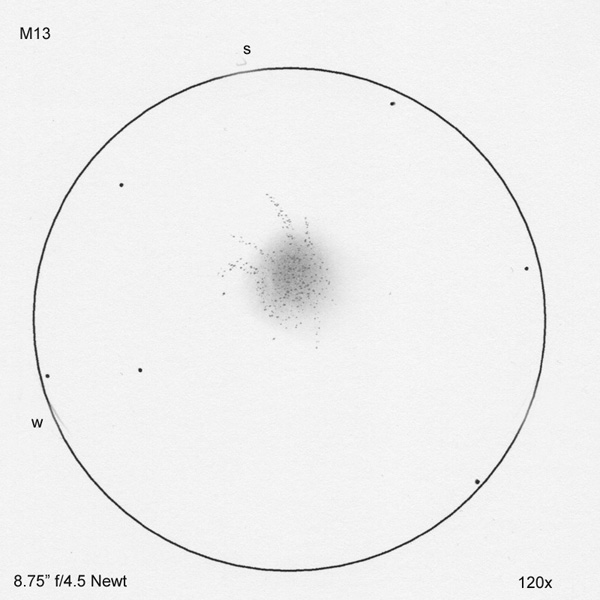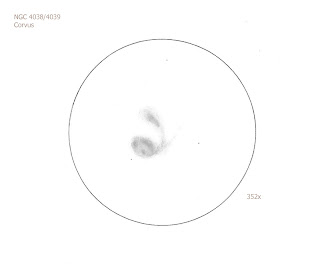Some galaxy sketches to brighten up your (and my) day – and mine is in serious need of a brighten up! These were made at the 2008 TSP, while observing with Larry Mitchell’s 36″.
NGC 5907, Draco
Spectacular, cutting right across the field of view in the 36″ at 232x. Prominent dark lane and a bright, elongated nucleus. Very thin, indeed. I am fond of edge on galaxies and this is one of the best.
Hickson 44, Leo.
A nice group of which NGC 3190 is the brightest member. 3190 (below centre) has a prominent dark lane. NGC 3187 (to the left of 3190) is faint and evenly bright. NGC 3185 (top) has a slight brightening towards the centre. NGC 3193 (bottom right) is round with a dense core and a fuzzy halo.
36″ at 232x.
NGC 4206 and 4216, Virgo
A lovely view. 4216, the large galaxy at right is very large, very bright and elongated. It also has a very bright compact core.
NGC 4206 is much smaller and fainter and does not have a bright core.
36″ at 232x.
M52 and NGC 5195, Arp 85, Canes Venatici
This is one of the best views I’ve ever had of this pair. You line up the huge dob, go up the ladder and this dinner plate, with the little saucer NGC 5195 next to it, is in the eyepiece.
It was hard to draw, as I was balancing near the very top of the ladder.
The arms are not uniformly circular as they appear in smaller apertures. They are bent, probably due to the influence of 5195 nearby distorting them. There are bright HII regions in the arms.
The bridge of material connecting them is easily seen and quite bright in the 36″ at 232x.
5195 is oval, distorted. the side nearest M51 is brighter than the side away from it. Fantastic.
‘From the notebooks’ does sound a little pretentious (I was going to say ‘poncey’!) but it’s quite a good title – and this stuff IS from the notebooks! – and posting old sketches is a good way of keeping the blog active while I scratch about for something interesting to post. It’s gone dead observing-wise here, due to the most appalling weather (August has been a total wash-out this year, with torrential rain, flooding and gales. I feel sorry for anyone on holiday here, especially if they’re camping) and the last few nights the Moon’s been in the way. The beginning of the month was okay for observing, with one okayish night, one good night, the Perseid peak, the Milky Way sketching session and that absolutely sensational night we had.
Anyway, some more ‘From the notebook’ type posts will appear over time, depending on what else I can talk about. It depends on how much observing I get in. I’m hoping the weather will improve during September.
Off topic, but still relevant (which I’ll come to in a minute) is my work situation. I’m currently doing a seasonal driving job delivering tourist guides to hotels, attractions, ferries and train stations, etc, which I like very much. It’s part time which suits me nicely as I can start what time I like – very handy after late observing sessions and all-night runs! However, with the tourist season winding down soon and just another couple of weeks to go of the main season, my hours will probably get reduced.
I can’t find anything else at the moment as the employment situation in the UK as a whole, not just where I live, is appalling. I’m getting interviews but then nothing comes of them, usually it’s because there’s always some git with more experience than me (although I am sure it comes down to pulling names out of a hat). Even the temping agencies have nothing – indeed the manager of one described the situation to me as ‘absolute crap’, and when even the agencies use words like ‘crap’ you know it’s bad indeed. The fact that a very real threat of a ‘double-dip’ recession is hanging over the country (although I do get the feeling the Bank of England and the Treasury are talking us into this, aided and abetted by the media) does not help the situation any.
Despite this, I am still planning to get a 20″ dob (I am one of these people who has to have something to aim for – I do NOT believe in just existing, because that’s just depressing and pointless), firstly buying that mirror-less scope I’ve mentioned in previous posts, as I already have most of the money for that. The mirror might take longer to acquire than I previously hoped, though, depending on what happens on the work front.
I am pleased to say the observing shed has held up in the recent bad weather. Some rain got blown in through the vents, as it has been pretty much torrential and blown horizontally for the past few days, but otherwise – touch wood – it seems more or less ok. I did seal up non-vent suspect points with duct tape and also fixed the roof down better, just in case as I don’t trust their flimsy method of attaching the roof. I also stuffed an old t-shirt into the vent where the rain was being blown in, I’ll remove this when the weather improves. Let’s hope it continues to be dry in there. The mirror also looks as if it’s remained condensation-free, so the silica gel cat litter seems to be doing the trick.

























